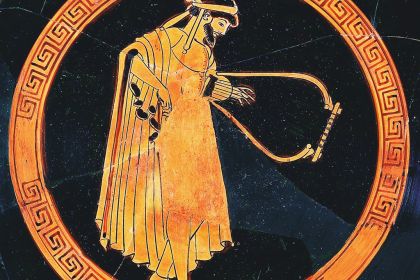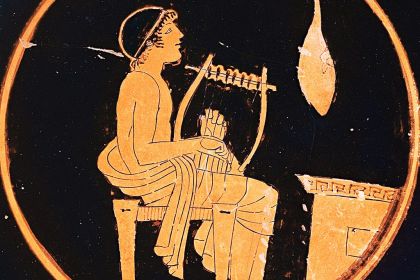Music Theory
Popular songs using Lydian mode

Muse Tuning the Lyra
Musical Mode: Lydian Mode
In Western music, the vast majority of classical compositions and popular songs are written using only two diatonic scales, major and minor. However, the diatonic system describes seven scales that are the basis of corresponding musical modes, historically named after the geographical regions of Ancient Greece: Ionian, Dorian, Phrygian, Lydian, Mixolydian, Aeolian, and Locrian.
The Ionian or major scale and the Aeolian or natural minor scale dominate Western music due to their universal harmonic structure which allows combining all three harmonic functions of tonic, subdominant, and dominant in the most advanced way. The remaining five scales have the status of modal and are used by composers only occasionally to evoke musical associations with a particular folk culture or historical period.
The Lydian mode is almost identical to the Ionian major mode, except for the fourth scale degree which is increased by a semitone. The fourth tonal degree is the basis for organizing the subdominant function so its alteration severely limits the usage of the subdominant group of chords, largely due to the fact that the triad rooted in the fourth degree is diminished chord.
C Lydian scale:


The Lydian mode is classified as a major one since the tonic triad built on the first scale degree is a major chord. Two more major chords in the Lydian mode are rooted in the second and fifth degrees while the minor triads can be built on the third, sixth, and seventh degrees. For example, C Lydian mode contains the following triads (denoted by Roman numerals and chord symbols): I–C, II–D, iii–Em, ivo–F♯dim, V–G, vi–Am, vii–Bm.
Due to its bright and happy mood, the Lydian major scale is not such a rare compositional technique, and its examples are easy to find both in classical music of any period and in popular songs of various genres.
A good example of a song with only three major chords of the Lydian mode is found in Freewill by the Canadian progressive rock band Rush released on their 1980 album Permanent Waves. The song's intro, verses, and bridges are based on just one chord chain in F Lydian: F–C–G or I–V–II.
Listen to Freewill by Rush:
Many songs are based on a simple alternation of two major chords built on the first and second scales degrees of the Lydian mode. For example, Fleetwood Mac's Dreams from their 1977 album Rumors features just two chords in F Lydian: F–G or I–II.
Listen to Dreams by Fleetwood Mac:
Landslide, another Fleetwood Mac track from the band's self-titled 1975 album, contains a well-developed harmonic structure that can be fully explained by C Lydian mode. Here are the chord sequences for the different sections of the song:
- verses C–G–Am7–G or I–V–vi7–V
- bridge C–G–Am7–G–C–G–Am7–D or I–V–vi7–V–I–V–vi7–II
- chorus G–Em7–C–G–Am7–D or V–iii7–I–V–vi7–II
Listen to Landslide by Fleetwood Mac:
The American band R.E.M. used the Lydian mode in their single Man on the Moon later released on their 1992 album Automatic for the People. The song, written in C Lydian, features a verse-chorus structure with an instrumental bridge following the second and third choruses.
The verses and bridge are built on two alternating chords:
- verses C–D or I–II
- bridge Em–D or iii–II
The five-line chorus contains a more advanced chord chain in C Lydian:
- Am–G or vi–V
- Am–G or vi–V
- Am–G–С–D or vi–V–I–II
- G–Am–С–D–G–Am–D or V–vi–I–II–V–vi–II
- G–Am–С–Bm–Am or V–vi–I–vii–vi
Watch Man On The Moon by R.E.M.
F Lydian mode is seen in the verses and chorus of the popular song Human Nature originally written by Steve Porcaro and released by Michael Jackson in 1982.
Here is the harmonic structure of the verses:
- F–G or I–II in lines 1-3
- F–Em7–Dm7–G or I–vii7–vi7–II in line 4
And here are the chord chains for each line of the chorus:
- G–C–Am–G or II–V–iii–V
- F–Em7–Dm7–Am or I–vii7–vi7–iii
- F–G–C–Am–G or I–II–V–iii–II
- F–Em7–Dm7–G or I–vii7–vi7–II
Listen to Human Nature by Michael Jackson:
The examples clearly illustrate the common practice of using almost any chords of the Lydian mode except for the diminished chord of the fourth scale degree. The subdominant function is still featured as shown in the chords built on the second and sixth scale degrees.
Finally, here's a quick look at another track entirely built around just two G Lydian chords G–A or I–II:
Listen to Jane Says by Jane's Addiction:
In theory, the looping repetition of any two major chords built on adjacent scale degrees separated by a whole tone can be defined as the alternation of tonic and supertonic chords in the Lydian mode. For example, the tonal center of the G–A chord sequence is G, and the two chords of the sequence are built on the first and second degrees, or the I–II of the Lydian mode. This chord chain can also be classified as alternation of the subtonic and tonic chords in the Mixolydian mode, though in this case, the tonal center shifts to A, and the chord progression is commonly denoted by the Roman numerals VII–I.
Discover more songs composed in Lydian major mode and check out their harmonic analysis in the following articles:
- Lost for Words: Pink Floyd's only Lydian song
- Beatles songs featuring Lydian mode
- Reelin' In the Years: the tandem of effective lyrics and one of the best guitar solos of all time
- The Bells of Rhymney: two major modal modes of famous protest song
- Peace Frog: the only Doors song featuring Lydian mode





also "head over heels" by tears for fears
only the intro and last section show the Lydian elements:
Serg - Great article - great resource. Thanks for publishing it. It's very helpful to hear popular songs that actually use the modes.
In another article you state that "Rebel Rebel" is in E Mixolydian. The main riff used in both the verses and chorus is basically D-E (I-II), similar to "Dreams" by Fleetwood Mac. Both songs end on the I chord which I thought to be the tone center.
Can you explain the difference? Is it because of the pre-chorus in Rebel Rebel (A-D-Bm-E)?
Also - would you consider "Here Comes My Girl" (Tom Petty) in Lydian?
Thanks in advance.
hi Ken, thanks for the flattering feedback! i love researching the harmonic structure behind songs and am glad to see it came in handy.
you're right, it's often difficult to determine Lydian or Mixolydian in the case of a simple alternation of two major chords whose roots are separated by the major second. i mentioned this in the last paragraph of this article.
i labeled E Mixolydian in Rebel Rebel as the whole harmony of the song fits easily into the structure of this mode. of course, i hear that every line of the verse starts with the D chord and it also closes the song. that is, the track should be considered Lydian/Mixolydian. however, there is no big mistake to attribute it entirely to Mixolydian, since there is a practice of ending a song with a non-tonic chord.
Here Comes My Girl definitely refers to A Lydian:
the choruses show a curious example of the harmonic sequence. here the segment of the sequence is formed by two chords V–I whose roots are spaced from each other by a perfect fourth. this segment is repeated starting from the six (vi–II) scale degree.
Dreams is not in F Lydian because the melody resolves to A, not F. Dreams is in Am, F being bVI and G bVII.
the A note is present in the F major chord as a third, so the melody resolves correctly.
on the other hand, the Am chord does not appear in the song, so it cannot be the tonal center.